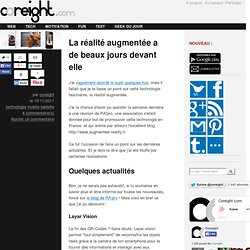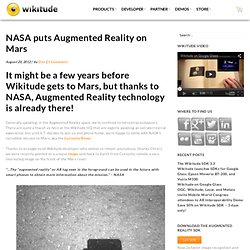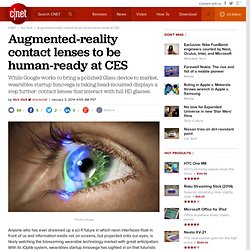

La réalité augmentée a de beaux jours devant elle. J'ai vaguement abordé le sujet quelques fois, mais il fallait que je te fasse un point sur cette technologie fascinante, la réalité augmentée.

J'ai la chance d'avoir pu assister la semaine dernière à une réunion de RA'pro, une association s'étant donnée pour but de promouvoir cette technologie en France, et qui anime par ailleurs l'excellent blog Ce fut l'occasion de faire un point sur les dernières actualités. Et je dois te dire que j'ai été bluffé par certaines réalisations. Quelques actualités Bon, je ne serais pas exhaustif, si tu souhaites en savoir plus et être informé sur toutes les nouveautés, fonce sur le blog de RA'pro !
Layar Vision La fin des QR-Codes ? Layar avait organisé un concours de création d'applications pour exploiter cette technologie, voici les 3 premiers pour les curieux : Reconnaissance d'affiches, de photos de produits ou même de plat (!) Unifeye Design String. NASA puts Augmented Reality on Mars - Wikitude. Generally speaking, in the Augmented Reality space, we’re confined to terrestrial endeavors.

There are quite a few of us here at the Wikitude HQ that are eagerly awaiting an extraterrestrial experience, but until E.T. decides to join us and phone home, we’re happy to settle with NASA’s incredible mission to Mars, aka the Curiosity Rover. Thanks to an eagle-eyed Wikitude developer who wishes to remain anonymous (thanks Chris!) , we were recently pointed to a unique image sent back to Earth from Curiosity, namely a very interesting image on the front of the Mars rover: “…The “augmented reality” or AR tag seen in the foreground can be used in the future with smart phones to obtain more information about the mission.” – NASA You read that right; NASA just put a piece of Augmented Reality technology on the surface of Mars!
Want to know what mysteries of time and space they’ve uncovered? Image Credit: NASA. [BtoC] Pourquoi la réalité augmentée ne décolle pas ? La réalité augmentée, autrement appelée RA, est une technique qui vise à insérer en temps réel un élément virtuel (2D ou 3D) dans une image réelle à partir d’un device.
![[BtoC] Pourquoi la réalité augmentée ne décolle pas ?](http://cdn.pearltrees.com/s/pic/th/pourquoi-augmentee-frenchweb-39479323)
Elle a fait son apparition auprès du grand public en 2009 avec l’application Layar et on prévoyait à ce moment une explosion du marché d’ici à 2010. Le nombre d’applications de réalité augmentée s’est ainsi multiplié à une vitesse fulgurante, le marché B2B a rapidement progressé, et les marques, cherchant à doper leurs ventes, ont appris à s’approprier la technologie et essaient d’offrir de belles expériences aux consommateurs. Pourtant, seulement 1 à 2% des utilisateurs de smartphones profitent aujourd’hui des applications de réalité augmentée et, mis à part le secteur du jeux, le marché du grand public stagne.
Alors pourquoi la réalité augmentée ne décolle-t-elle pas? Première probabilité, le grand public ne comprend pas l’utilité de la réalité augmentée. Labs takes Augmented Reality to the web browser. More than three years ago, in October of 2008, Wikitude was the world’s very first Augmented Reality (AR) Browser.

At the time Wikitude’s founder Philipp Breuss-Schneeweis pioneered the AR apps space as the Google G1 entered the market providing access to the required sensors like digital compass, GPS and accelerometer – the three basic components necessary to enable AR on a smartphone – for the very first time. A new era is about to begin as Wikitude is now bringing AR to the web.
The Wikitude lab has created an AR solution called “AR window”, which enables any mobile webpage to include Augmented Reality. From now on mobile web pages will be able to open up the camera view of its smartphone to view the live video stream with additional augmented content on top of it. This means that the immersive experience of connecting the real world with computer generated content from the internet is now brought to a much grander stage: the world wide web. Augmented-reality contact lenses to be human-ready at CES. Anyone who has ever dreamed up a sci-fi future in which neon interfaces float in front of us and information exists not on screens, but projected onto our eyes, is likely watching the blossoming wearable technology market with great anticipation.

With its iOptik system, wearables startup Innovega has sighted in on that futuristic vision, designing special contact lenses that will read the light from projectors fitted to glasses. In doing so, it's inching closer to a product that may rival even Google in its wearable ambition. Optical head-mounted displays, or devices that augment our vision either through full-blown glasses or fixed optics that float screens in our peripheral sight, have come to epitomize the cutting edge of wearable tech.
Google's Glass wearable has yet to exit its beta "Explorer Program" -- though prescription lenses appear to be on the way -- and still tends to freak people out and keep the critics testing it in the wild apprehensive of wearing it in public settings.